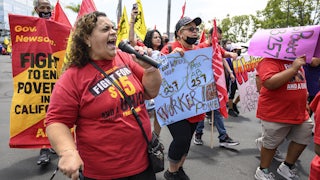For all the progress the United States has made on climate change—having just finally passed a bill aimed at reducing emissions—it’s still a political third rail to go directly after the leading driver of rising temperatures: fossil fuels. The Inflation Reduction Act’s passage in Congress was premised on providing giveaways to oil and gas drillers, whose indefinite profits Democratic Party leaders don’t see as incompatible with a habitable future. For years that was also the case in California, which clung to its contradictory status as both a leader on climate policy and a prolific fossil fuel producer. That’s now changing.
Among the suite of climate bills the California legislature passed in recent weeks, at the request of California Governor Gavin Newsom, is a remarkable, once unthinkable challenge to the state’s oil and gas industry. Senate Bill 1137 prohibits new wells from being built within 3,200 feet of schools, nursing schools, hospitals, and other “sensitive receptors,” per the bill’s text. Still bolder is the bill’s effective ban on approvals to “rework” existing wells within the same radius: preventing the state’s oil and gas regulator (CalGEM) from approving Notices of Intention to drill, redrill, deepen, or permanently alter well casings within the “health protection zone” established by S.B. 1137. Roughly a quarter of California’s operational wells—those within the setback zone—could need to relocate or shut down in the coming years. Drillers and their trade associations are predictably apoplectic. So how did California get comfortable taking on one of its most important industries?
It didn’t happen overnight. Of the more than seven million Californians who live within a mile of oil and gas wells, some 90 percent are low-income or nonwhite. Those living next door to drilling have long raised alarm bells about its harmful effects and advocated for the kind of setback rules already in place in Wyoming, Texas, and Colorado, in addition to more stringent air and water quality rules. California’s muscular climate and environmental justice groups have been a driving force behind the state’s landmark climate legislation too. But policies to challenge fossil fuel extraction head-on typically hit a wall, including previously introduced setback bills.
The successful fight this time around was headed up by the Voices in Solidarity Against Oil in Neighborhoods, or VISION, coalition, composed of environmental justice groups in Kern and Los Angeles County, working alongside bigger green groups and progressive legislators. “It did not take California’s experience of wildfires and drought and extreme weather to convince leaders to take action,” said VISION Coalition coordinator Koby Naseck. “It takes concerted action from frontline environmental justice residents who won’t give up even when faced with big oil and all their money.” He noted that the law is stronger than the setback regulations Newsom announced late last year, which will apply only to new wells and fall under the purview of agencies in which many environmental and climate justice advocates have little faith.
Kern County, for instance, containing more than 40,000 wells, produces some 70 percent of California’s oil and gas and has some of the country’s worst air quality. The hills surrounding Kern County and other Central Valley communities trap the volatile organic compounds (benzene, xylene, and formaldehyde) found in the air around pumpjacks. Pollution from so-called “neighborhood drilling” has been linked to nosebleeds, vomiting, fatigue, memory loss, and even cancer. Wastewater from fracking operations has been found to contain arsenic and other contaminants that can seep into municipal water supplies. Bakersfield resident Cesar Aguirre, an organizer with the Central California Environmental Justice Network, or CCEJN, a VISION coalition member, relayed the story of the Martinez family in nearby Arvin. In addition to suffering chronic health issues, he says, they can’t hang pictures on their walls because nearby pumpjacks shake the house too often.
Since Kern County is also a major agricultural producer, though, it can be difficult to isolate what exactly is causing residents’ health problems. “It’s very hard to say that the oil and gas pump in my backyard is causing the fatigue, dizziness, nosebleeds, and headaches,” Aguirre said. “It could be the pesticides in the field next to my house or the dairy a half-mile away.” Existing air quality rules, he adds, contain considerable loopholes, including one that exempts companies that produce fewer than 5,000 barrels per year.
While warnings about gas leaks from working-class Latino residents have mostly fallen on deaf ears, regulators responded swiftly to a gas leak in the wealthier, whiter Bakersfield neighborhood of Morningstar. CalGEM, which employs just 2,500 investigators statewide, convened an emergency community meeting and dispatched field engineers, and the California Air Resources Board went door to door asking residents if they were experiencing health issues, Aguirre told me. The story made national news earlier this summer, when investigators found 21 idle wells were leaking methane. “Since then we’ve found more than 40 wells leaking in Kern County, and there haven’t been any more community meetings or door-knocking,” Aguirre added, saying such protocols should be the norm rather than the exception. To date, existing loopholes have kept regulators from even recording information on the dangers posed by wells that produce too little oil and gas each year to come under their jurisdiction. While giving credit to the longtime work of communities living next door to drilling, Aguirre also offered a more cynical view on Newsom’s decision finally to solicit setbacks legislation: “He took action because a leak happened in a white neighborhood.”
Though the bill is on Newsom’s desk, Aguirre worries that industry pressure could cause lawmakers to water it down to apply only to new wells before he signs it. “I don’t trust the government to keep the law as strong as it is. There’s always compromises that are made, and sacrifices zones are always the ones that pay the price for that compromise,” he said, adding that CCEJN and VOICES will keep pressure on Newsom to sign the bill as is.
There are broader political dynamics at work too in the climate wins this session, which included a 2035 ban on internal combustion engines and $54 billion in climate spending. Newsom is widely thought to be seeking higher office and looking to burnish his reputation as a climate champion. There’s also the fact that climate policy is now a long-standing feature of California politics. Especially with the passage of the Inflation Reduction Act, the Golden State’s energy transition is now firmly a matter of when, not if. And groups that have opposed policies to restrict drilling in the past are starting to take a different view.
“Oil can’t kill stuff on their own. They can spend a lot of money, but they are radioactive politically in California,” says David Weiskopf, senior policy adviser at NextGen Policy and a veteran of California climate policy fights. Traditionally the oil and gas industry has had to lean on other powerful groups influential in Democratic Party politics. That has long meant an alliance with the building trades, including unions that represent refinery and utility workers who would join forces to defeat certain kinds of climate legislation. But this year, the California & Nevada State Association of Electric Workers; Coalition of California Utility Employees; California State Pipe Trades Council; and the Western States Council of Sheet Metal, Air, Rail and Transportation Workers broke ranks with the building trades—albeit subtly. In a letter urging lawmakers to pass Newsom’s climate package, the unions argued that “while we cannot endorse the inclusion of the oil well setback provision, we must advocate for what’s in the best interest of our members,” adding that the package as a whole would “create tens of thousands of high paying construction jobs for years to come.” The State Building and Construction Trades Council of California opposed the package outright. “One of the takeaways I’m trying to focus on is that the political order of any given moment isn’t permanent,” Weiskopf said.
The news out of Sacramento this session isn’t all good for climate and environmental justice groups. The price of getting setbacks and other wins may well have been boosting policies that state greens have tended to oppose. In the same session, the legislature passed bills to put guardrails on carbon capture and storage while also streamlining the permitting process around it. Though the measure includes a ban on injecting captured carbon to drill for more oil and other protections, critics argue that it boosts an “ineffective, unsafe and expensive technology that prolongs the polluting fossil fuel industry and puts communities at risk,” as the Center for Biological Diversity wrote in its press statement on California’s climate bills. This session, the legislature also voted to extend the life of the Diablo Canyon nuclear facility, which a number of climate groups have lobbied to shut down. Weiskopf reasons that the bills passed this session reflect the evolving politics of the state’s energy transition: Many now see a future in so-called carbon management, even if such technologies remain far off and, critics argue, dangerously speculative.
As climate groups nationally look to improve on the shortcomings of the Inflation Reduction Act—and encourage the Biden administration to ditch its “all of the above” approach to energy policy—California’s experience could be instructive: to keep fighting, even when there are pretty decent laws on the books.






